E. G. W. Dietrich
Ernest George Washington Dietrich, AIA (February 22, 1857 – December 24, 1924) was an American architect. Born and raised in Pittsburgh, Pennsylvania, Dietrich relocated to New York City in 1886[1] where he would practice for nearly forty years. His work included the design of churches, libraries, hotels, commercial and public buildings, but he is most highly regarded for his residential designs in the shingle, colonial revival, and arts and crafts styles. In cooperation with furniture designer Gustav Stickley, Dietrich designed the first “Craftsman House” published in The Craftsman magazine in May 1903.[2]
Early life
E. G. W. Dietrich was the oldest of six children born to German immigrants Jacob and Johanna (Roenigk) Dietrich.[3] He graduated from Duff's Business College and attended the Western College of Pennsylvania- now the University of Pittsburgh.[4]
Career
E. G. W. Dietrich began his architectural training at the firm of James W. Drum and David I. Kuhn in Pittsburgh.[4] In the fall of 1881, he moved briefly to Brooklyn, New York and published several of his designs in architectural periodicals at this time;[5] however, by September 1882, he had returned to Pittsburgh to work for architect James T. Steen.[6]
In 1883, Dietrich formed a partnership with Charles M. Bartberger (1850-1939),[7] the son of well-known Pittsburgh architect Charles F. Bartberger. The firm of Bartberger and Dietrich soon became successful receiving commissions for churches, schools, public buildings, and houses. While most of their projects were in Western Pennsylvania, Dietrich designed several notable houses in Cincinnati, Ohio, and Warwick, New York. In Warwick, his "picturesque" designs for side-by-side houses for future mayor Clinton Wheeler Wisner and his cousin Louise E. Wisner attracted much attention.[8] With prominent contacts and the promise of future commissions on the East Coast, Dietrich ended his partnership with Bartberger and moved his practice to New York City in the fall of 1886 setting up an office at 294 Broadway.[1]
Shingle Style
While Dietrich's earliest designs were typical of the late Victorian period, he soon found his voice designing structures with dramatic lines, minimal ornament, and using natural materials. For his later Shingle Style designs, Dietrich combined gambrel-roofed forms with low turrets and arched openings. In his book The Architecture of the American Summer, The Flowering of the Shingle Style, Professor of Architectural History at Yale University Vincent Scully noted Dietrich's mastery of the Shingle Style and featured several of his representative designs.[9]
Colonial Revival
Dietrich designed his own home in the Colonial Revival style. Completed in the spring of 1891,[10] "Sandanona" stood on Bay Parkway in Bensonhurst-by-the Sea, a private community on the shore of New York's Lower Bay. An early proponent of the Colonial Revival style, his designs predated the 1893 World's Columbian Exposition credited with popularizing the style. While the overall massing of the houses Dietrich designed in this style appear ordered and symmetrical, the asymmetrical floorplans are a continuation from his Shingle Style work. As was typical for the time, Dietrich worked in both styles often blurring style boundaries and combining elements of each.
Arts and Crafts
Gustav Stickley promoted the Arts and Crafts movement in the United States through his furniture designs and by founding The Craftsman magazine in October 1901.[11] The Arts and Crafts ideals of unnecessary ornament; local, natural materials; and fine workmanship were a natural fit with Dietrich's own ideals and design style. In the February and April 1903 editions of The Craftsman, Dietrich's "The Cottage Quality" presented views, floorplans, and an essay describing the virtues and thoughts behind his design.[12][13] Then in May 1903, the magazine published the first "Craftsman House" a design by Dietrich in cooperation with Stickley.[2] Featuring an essay and drawings by Dietrich including an exterior view, floor plans, and detailed interior views showcasing Stickley furniture, this was the first time this term had been used in the magazine and was the precursor to the "Craftsman Homes" series starting in 1904.
Dietrich continued to advance and refine his work in the Arts and Crafts style. Societal changes leading up to and following World War I resulted in fewer large country house commissions, and Dietrich changed his focus to more modest residences, churches, and other public buildings.
Professional partnerships and collaborations
Throughout his career, Dietrich practiced in partnership or collaboration with several architects including:
Charles M. Bartberger; A. Morris Stuckert; Manly N. Cutter; Henry La Pointe; Arthur H. Smith; and Julius J. Diemer
Personal life and death
On October 12, 1884, E. G. W. Dietrich married Eliza Estelle Melhorn (1858-1924) the daughter of Lutheran minister Rev. John K. Melhorn who officiated the ceremony.[14] The Dietrich family grew to include six sons.[15] Eliza Estelle Dietrich died on April 30, 1924.[16] On December 24, 1924, E. G. W. Dietrich suffered a fatal heart attack while waiting for a Long Island Railroad train at the Freeport, NY station near his home.[17] Interment of Dietrich, his wife, and sons Emerson and Krotel is in Green-wood Cemetery, Brooklyn, NY.
Associations
American Institute of Architects, Brooklyn Chapter[4]
Fine Arts Federation of New York[4]
Selected works
| Image | Building | Year | Location |
|---|---|---|---|
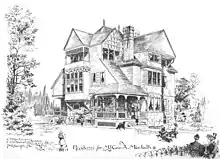 |
George A. MacBeth House | 1884 | Pittsburgh, PA |
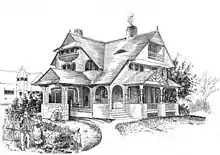 |
"Dolce Domum"
Louise E. Wisner House |
1884 | Warwick, NY |
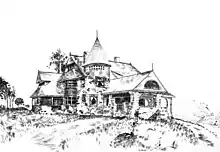 |
"Fieldstone"
Thomas E. Jones House |
C. 1887 | Scranton, PA |
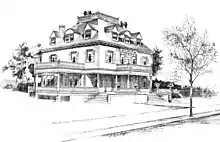 |
"Sandanona"
E. G. W. Dietrich House |
1891 | Bensonhurst-by-the-Sea, NY |
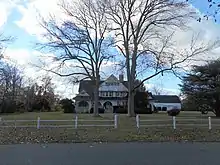 |
John Mollenhauer House | 1893 | Bay Shore, NY |
 |
"Hearthstone"
E. Starr Sanford House |
1895 | Danbury, CT |
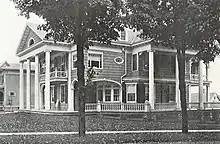 |
"Hallhurst"
Frederick P. Hall House |
1896 | Jamestown, NY |
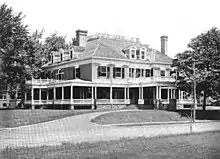 |
Sylvanus L. Schoonmaker House
later William W. Coriell Mansion |
1896 | Plainfield, NJ |
 |
Robert N. Marvin House | 1897 | Jamestown, NY |
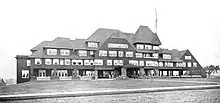 |
Red Swan Inn | 1902 | Warwick, NY |
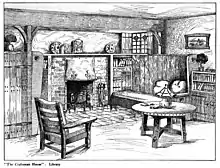 |
Craftsman House | 1903 | |
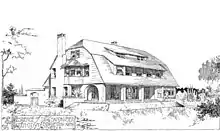 |
Dr. George Sandhusen House | C. 1915 | Garden City, NY |
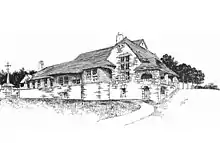 |
Remodeled Hay Mow into Bungalow | C. 1917 | near Lyme, CT |
External Links
References
- "Untitled". The Builder and Wood-worker. 22: 172. November 1886 – via ProQuest.
- "The Craftsman House". The Craftsman. 4: 82–92. May 1903. hdl:2027/mdp.39015014541307 – via Haithi Trust.
- Tenth Census of the United States. U.S. Census Bureau. 1880. p. 46.
- Stangle, William H. and Charles C. Wagner (May 1926). "Obituary: Ernest George Washington Dietrich". Journal of the American Institute of Architects. 14: 238.
- Dietrich, Ernst G. W. Dietrich (December 1881). "Cabinet". The Builder and Wood-worker. 17: 220. hdl:2027/mdp.39015036020207 – via Haithi Trust.
- Steen, James T. (October 7, 1882). "HOUSE FOR J. R. MCGINLEY, PITTSBURGH, PA. MR. JAMES T. STEEN, ARCHITECT, PITTSBURGH, PA". American Architect and Building News. 12: 354. hdl:2027/njp.32101080160995 – via Haithi Trust.
- Bartberger, Charles M. and E. G. W. Dietrich (December 22, 1883). "House Near Pittsburgh, Pa". American Architect and Building News. 14: 417. hdl:2027/njp.32101080161019 – via Haithi Trust.
- "Two Modern Villas". Warwick Dispatch. August 13, 1885. p. 3.
- Scully, Vincent (1989). The Architecture of the American Summer, The Flowering of the Shingle Style. New York: Rizzoli. p. 9.
- "Bensonhurst Notes". Real Estate Record and Builders' Guide. 47: 649. April 25, 1891 – via Columbia University Libraries Digital Collection.
- "Untitled". The Craftsman. 1. October 1901.
- Dietrich, E. G. W. (February 1903). ""The Cottage Quality"". The Craftsman. 3 (5): 280–282. hdl:2027/coo.31924015272275 – via Haithi Trust.
{{cite journal}}: CS1 maint: date and year (link) - Dietrich, E. G. W. (April 1903). "An Interior". The Craftsman. 4: 57. hdl:2027/mdp.39015014541307 – via Haithi Trust.
- "Personalities". The Evening Penny Press (Pittsburgh). November 13, 1884. p. 1.
- Twelfth Census of the United States. U.S. Census Bureau. 1900. p. 21.
- "Deaths". Brooklyn Daily Eagle. May 2, 1924. p. 24.
- "E. G. W. Dietrich Dead". The Hempstead Sentinel. Dec 25, 1924. p. 1.